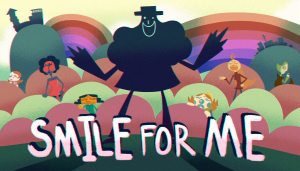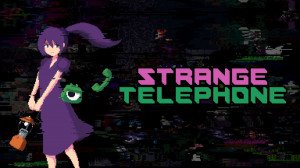Review for The Black Widow

In the late eighteen hundreds, Louisa Collins was the last woman hanged for murder in Australia after being accused of killing two husbands in a period of just over a year. What makes her case particularly disturbing is that she was brought before the courts four times before being sentenced to death, the juries of the first three trials failing to convict her. Using a Her Story-esque format and pieced together from original court records and actual letters, Flux’s The Black Widow delves into her controversial case through a unique means of contacting her beyond the grave. Hearing Louisa’s own words, it’s up to players to decide for themselves if she’s innocent or guilty. It’s fairly novel to see a game tackle real biographical events, although the result here is rather unmemorable due to the limited production values and inherently fragmented nature of its one-sided story, negating much of its emotional impact.
The Black Widow focuses on the deaths of Louisa’s husbands, both of whom were wretchedly ill before dying. Collins maintains her innocence right to the end, but as she is the only one offering testimony, naturally there is a certain degree of unreliable narration to be expected. To learn Louisa’s story, a Ouija board interface is used to communicate with her by entering relevant keywords. A variety of recorded video clips are then returned of her speaking at her trial in a manner related to the keyword in question. If you’ve played Her Story, it’s all very familiar. Asking about one topic will usually provide ideas and clues about other subjects to bring up next.
In other word-based mystery games of this sort, usually a twist or surprise emerges to cause a reconsideration of everything that’s come before. That “aha!” moment doesn’t really exist here. Louisa is very matter-of-fact about things and there’s never the sense that she’s holding anything back (save for admitting she actually committed the murders, if she even did). There’s enough ambiguity overall that some replies maybe lean towards her being guilty while others maybe lean towards her being innocent. While that’s probably intended to make players feel torn about the truth in the same way that her first three juries reached an impasse, it doesn’t make for a very satisfying story. There’s no real resolution or climax, and ultimately what’s conveyed feels like little more than an extended Wikipedia article. It’s not bad, per se, just not very fulfilling.
I think part of the reason for the lack of resonance is due to the scattered nature of this form of gameplay. Some of Louisa’s comments clearly come from near the end of her trials, expressing dread of the hangman’s noose and making more emotional pleas. However, given that your keywords can result in a random assortment of clips from all across her time under suspicion, the weight of those pleas does not fully land, being interspersed with more clinical, simple statements of fact. The Black Widow ultimately engages more on an intellectual level than an emotional one, and with no dramatic revelation at any point, what’s presented all tends to blur together.
The game takes place entirely on one screen with a Ouija board placed in the middle, the upper half given over to an ethereal black and white image of Louisa’s face and the lower half displaying the traditional alphanumerical and other textual markings. Keywords are entered using either the planchette-shaped mouse pointer to select letters from the alphabet or by typing the letters directly on the keyboard. The digits from 0 to 9 are also needed for selecting resultant videos to play. The specialty options of “Yes” and “No” are used only for resuming and pausing videos respectively, as this isn’t a real conversation where you interact with Collins directly.
Inputting a word that Louisa recognizes can return up to ten video clip results, represented by the numerals on the board. In some situations certain digits are skipped; for example, results might show 1, 2 and 4 in black but leave 3 greyed out and unable to be clicked. It took me a while, but I eventually determined that the game only highlights numbers for videos that have not been viewed already. This is helpful when trying to avoid repetition, as the average clip is rather long at about thirty seconds.
Being (apparently) unable to replay videos unfortunately did lead to one quandary for me, at least initially. Things that I thought were unimportant on first viewing, I later felt needed to be heard again. The problem is that with the number options no longer accessible, I couldn’t figure out how to do so and was forced to plough on and hope for the best. Also causing problems for me at first, the game did not seem to have subtitles for its videos. This was awkward when I needed to know the specific spelling of names of places and people to try as search topics. Eventually, however, I discovered that all these troubles could have been avoided if the game didn’t hide its most user-friendly features.
Above the “Yes” and “No” options on the Ouija board are two wooden flowers that look merely decorative, but it turns out that clicking on each presents a popup menu. One provides a list of all keywords tried that returned videos, and selecting entries from this list will let you watch any clip even if you’ve already seen it. The other, more critical hidden menu has options to turn on subtitles (which I would have dearly loved earlier in the game), and enable hints, which recommend words to try after waiting a short period of time. The only way to know that, however, is a page of help text available from the main menu, and even though it mentions the flowers, here’s what it says: “Use the flowers above YES and NO to guide your path. They will remember where you’ve been, even if you’ve pressed GOOD BYE to leave the conversation. Use them to plot or journey, or return to where you started.” I think I can be forgiven for not understanding this meant options for subtitles, hints, and rewatching videos.
I came upon the flower options quite by accident. The Black Widow has 123 videos to find in total. Progress is represented by a metallic border surrounding the Ouija board, which at the start of the game is entirely silver. As more videos are watched, the border is slowly filled in with a golden hue. (You’ll know all clips have been found once the entire border has turned gold.) When I had fewer than ten left to find, I hit a wall and couldn’t think of any good keywords to search in order to proceed any further. Only then did I exit out and turn to the help page, which mentioned a “Hints” option but not where to find it. With nothing else to check in the interface, I clicked on the flowers. Voila! That’s when I discovered the features I’d been missing all along. Clearer wording on the help page or ideally some form of brief in-game tutorial would have helped immensely.
The other idiosyncratic quirk of the interface has to do with the Escape key. It’s been standard for years that hitting this will take players back to the main menu. Not so in The Black Widow. Here Escape really means escape, instantly killing the game and dropping you back to the desktop. While jarring, this wouldn’t be too bad except that you also lose all progress made to that point. The proper way to exit is to select “Good Bye” from the board, which records the current state of your investigation so that it can be resumed there later. There is no manual way to save the game at all.
I ran across the unfortunate exit-and-reset surprise after having played nearly an hour. Not counting the time I lost from my progress being obliterated, my total play time was just under three hours. After discovering all the videos, I found a “Full Story” option had been made available from one of the flower menus. Selecting this played all of the videos in succession, which took just under two hours to run. It’s interesting to be able to seamlessly go through the whole story front to back to put everything in its proper context, and it allows for more focus on the emotional side of Louisa’s testimony than the fragmented search process.
The videos themselves depict nothing but Louisa’s face, or rather a CG replication thereof. Her visage definitely falls into the uncanny valley, with mouth positions that don’t sync to her spoken words, an almost animated cartoon stretch-and-squash quality to her cheeks and brows at times, and a lack of any emotional expressions even when her voice is quite strident. And yet in a weird, campy way, this puppet-like presentation of Louisa actually fits the semi-spooky atmosphere of the whole supernatural conceit. The clips also manage to evoke a certain sense of history, especially as Louisa uses antiquated vocabulary and adopts a more formal delivery than is true of contemporary society.
On the audio front, the experience is equally spartan. Louisa speaks with what sounded to me like a lower-middle class English accent rather than Australian, and occasionally I found it a little difficult to discern what she was saying – hence the desire for subtitles. For example, several times she referred to something that I swore was pronounced “Ruvhawnrets”. It was only after encountering a video where she actually spelled the name out one letter at a time that I came to understand she was saying “Rough On Rats”, the name of an arsenic-based rat poison that was popular at the time due to an epidemic. Audio levels also tend to vary from clip to clip, with most being a reasonable volume but a few outliers either being quite soft or a touch too loud. Aside from these occasional difficulties, the lines are well spoken and Louisa’s voice is easy to listen to. The remaining sounds consist solely of clicking when selecting or typing letters, along with a somewhat ominous, metallic blowing wind in the background.
With all the different game engines out there these days, and the minimalistic approach to the presentation here, I was surprised to note a “Powered by YouTube” label in The Black Widow’s credits list. I assume this accounts for the message on the main menu indicating that an internet connection is required to play the game. For those on a metered or limited bandwidth service, the constant running of videos may prove problematic and costly. Especially as between actual responses, additional videos are shown of Louisa’s head shifting and fidgeting about to keep the screen animated.
Using an adventure game to explore history, and particularly historical personages, is certainly an intriguing prospect that I wouldn’t mind seeing more of in the future. As a biographical piece about a supposed murderess who was tried four times before being found guilty, The Black Widow is faithful to the events of the past. However, with no moments of epiphany or unexpected twists, and with its few emotional appeals being scattered among far more matter-of-fact commentary, the overall story fails to make a lasting impact despite its innately dramatic subject matter. And with only Louisa’s perspective, there’s not enough context to view the circumstances or her testimony through any lens but her own. It’s certainly not a bad attempt, just a little too shallow for its own good. If you’re looking for something to scratch that Her Story itch, this may help. Just don’t expect it to stay with you very long after playing.





























